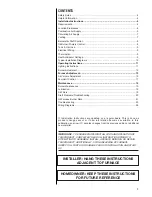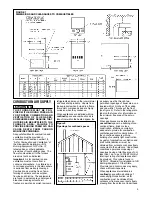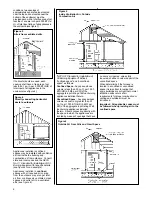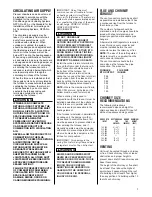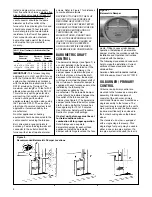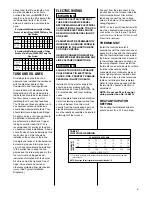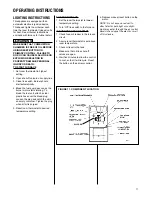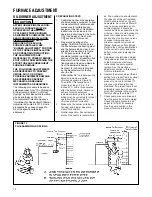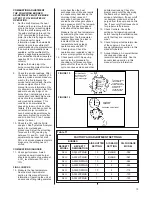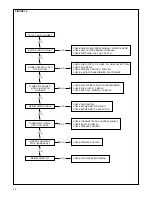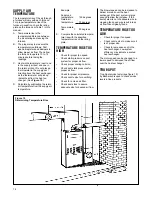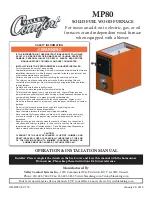
3.
If the electrode position is correct,
the tips should be positioned where
the identifying marks on the gauge
intersect. These two lines
determine:
a.
Correct tip spacing above the
nozzle.
b.
Correct tip spacing ahead of
the nozzle.
The actual distance between
electrodes must be correct /-
1/32".
4.
If the electrode position is not
correct, the electrodes must be
readjusted and rechecked.
NOZZLE POSITION
1.
Insert the nozzle line/electrode
assembly into the air tube (see
figure 18).
2.
Place the wide section of the
gauge against the burner head
face with 1-1/8" wide end of the
gauge inserted into head.
3.
Slide the nozzle line/electrode as-
sembly forward until the nozzle
touches the gauge.
4.
Secure the adjustable plate on the
burner housing side by tightening
the screw. Then tighten the nut,
securing the nozzle line where it
passes through the side of the
The T231H nozzle, electrode and head
position gauge (see figure 16) is used
to correctly position the electrodes,
nozzle, and head. The gauge is the
best way to ensure that these adjust-
ments are correct.
This gauge is used on the Beckett
model "AFG" burners.
ELECTRODE POSITION
1.
With nozzle line/electrode assem-
bly out of the burner, place the 1-
1/8" wide gauge edge against the
face of the nozzle and between the
electrode tips (see figure 17).
2.
Position the gauge so the center
scribe mark is in line with the
nozzle orifice. (Do not scratch the
nozzle face)
15
housing. This locks the assembly
into position.
The nozzle should now be located
properly with 1-1/8" set back from
the face of the burner head.
NOZZLE CONCENTRICITY
For proper burner operation the nozzle
must be concentric with the burner
head opening.
1.
With the gauge inserted into the
head (see figure 14), the nozzle
orifice should be approximately in
line with the center scribe mark on
the 1-1/8" wide edge of the gauge.
The maximum eccentricity
allowable is identified by the two
outer scribe marks (+/- 1/16").
2.
Rotate the gauge to assure
concentricity in a side-to-side as
well as up-down position.
If the nozzle is not concentric
within allowable limits, it generally
indicates either improper
construction or damaged parts. Do
not use. Replace with a correct as-
sembly.
AIR VOLUME
ADJUSTMENTS
The amount of air delivered by the
blower is affected by the resistance of
the ductwork and registers. The factory
adjustment of the blower speed has
been made to suit the average
installation, designed and installed
according to the manuals published by
the National Warm Air Heating and Air
Conditioning Association. The speed of
the direct drive blower can be changed
by rewiring motor leads as described in
the wiring diagrams.
ELECTRODE ADJUSTMENT
Figure 16
T231H
Figure 17
Electrode Adjustment
Figure 18
Nozzle Depth and Concentricity
Summary of Contents for LX2000 Series
Page 27: ...27 PARALLEL WIRING UPFLOW OIL FURNACES SCHEMATIC...
Page 28: ...28 HEATING AND COOLING CONTINUOUS LOW SPEED BLOWER SCHEMATICFIGURE 38...
Page 29: ...29 FIGURE 38 FOR MODELS WITH UTEC 1012 925 INTEGRATED FURNACE CONTROL...
Page 30: ...30...
Page 31: ...31...
Page 32: ...32 CM 898...



